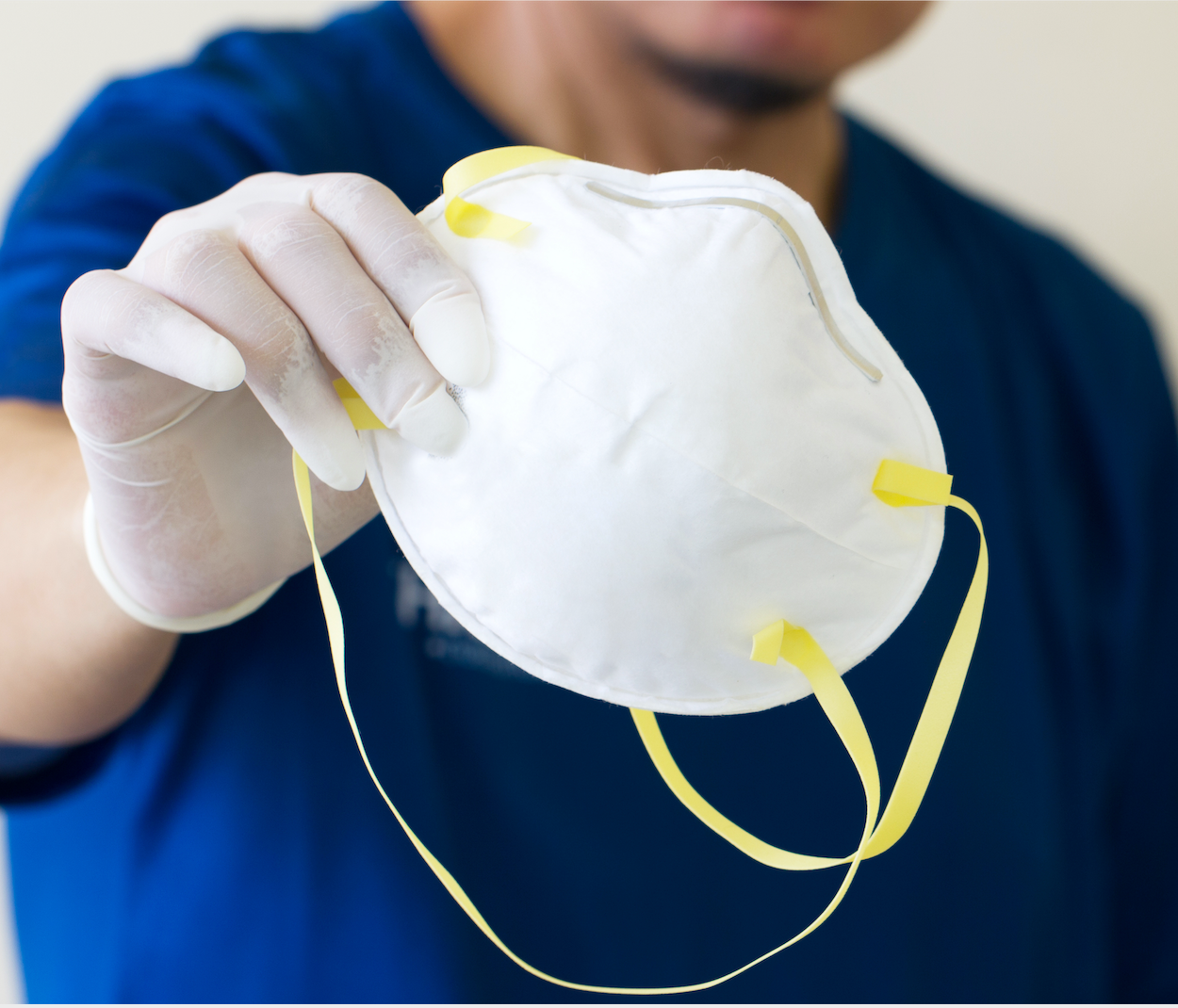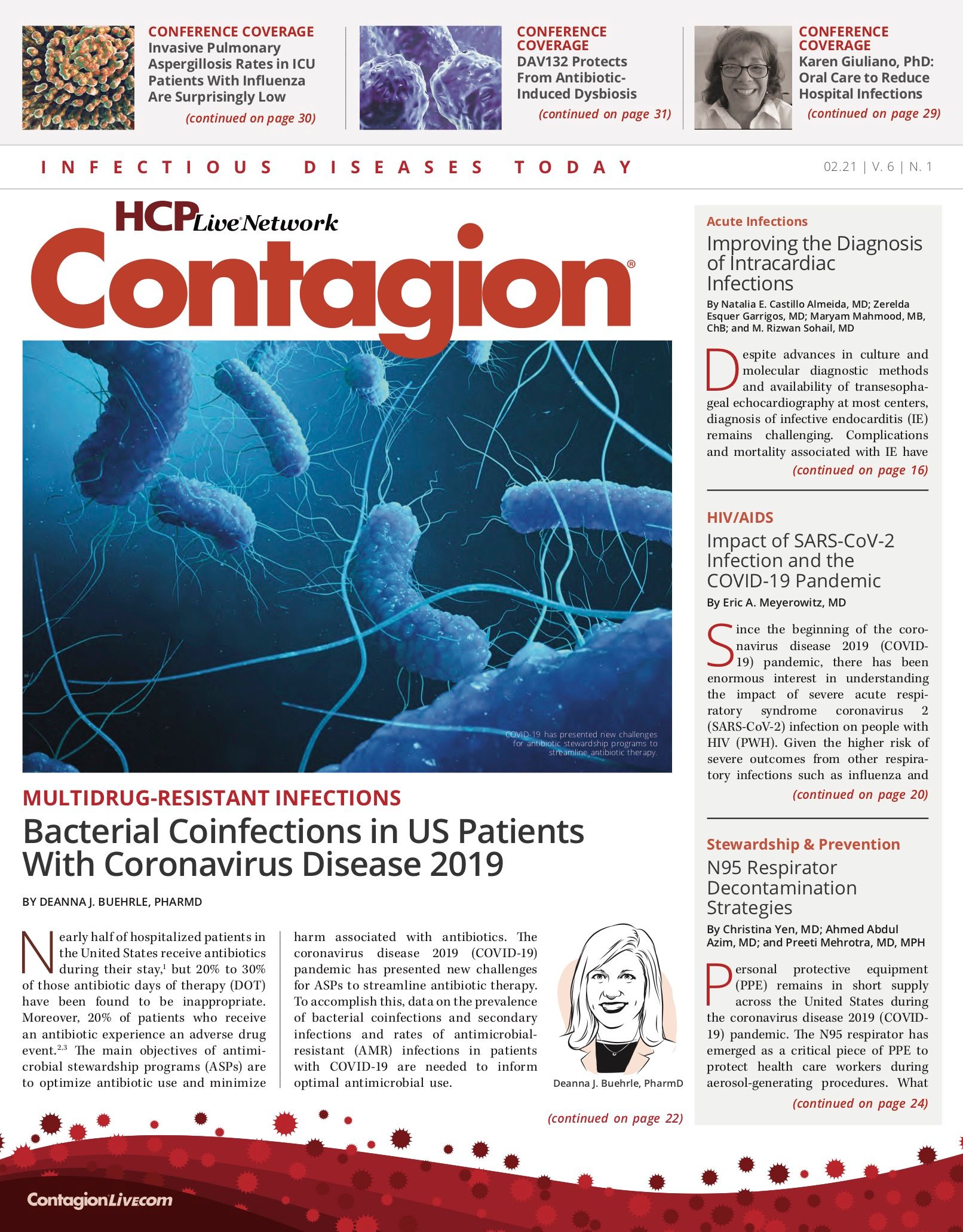From Single-Use to Multi-Use: A Brief Review of N95 Respirator Decontamination Strategies
This indispensable personal protective equipment did come up in short supply and reuse strategies has become a topic of great interest and research.

Personal protective equipment (PPE) remains in short supply across the United States during the ongoing coronavirus disease 2019 (COVID-19) pandemic. During this time, the N95 respirator has emerged as a critical piece of PPE to protect health care workers during aerosol-generating procedures. What makes an N95 respirator different from standard surgical masks is that it is a particulate-filtering face piece worn to filter at least 95% of airborne particles measuring as small as 3 microns in diameter. To extend the quantity of available respirators, PPE reuse— something once done only in low-resource settings—has become necessary in resource-rich settings as well, as recommended by the CDC in situations where PPE is running low.1
To complement reuse strategies, PPE decontamination has become a topic of great interest and research. First, it is important to distinguish the difference between cleaning and decontaminating PPE. Cleaning is the initial step of removing organic material including microorganisms from equipment, but it does not necessarily inactivate enough microorganisms to render the equipment safe for usage. Decontamination inactivates or eliminates pathogenic microorganisms, allowing for safe usage. Therefore, in all of the following decontamination strategies, masks with visible soiling are discarded prior to decontamination during the quality assessment phase.
Finally, to increase the PPE supply, a successful decontamination method must achieve adequate target organism inactivation without compromising respirator fit and filtration. Here, we will review 3 common sterilization modalities currently in use for N95 respirator decontamination, how they work, and their strengths and limitations.
Ultraviolet Germicidal Irradiation
Ultraviolet (UV) light has long been used for environmental disinfection in health care; UVC wavelength (as opposed to UVA or UVB) light has been studied and approved by the National Institute for Occupational Safety and Health for use in health care settings to kill organisms hardier than viruses, such as Mycobacterium tuberculosis.2 Ultraviolet germicidal irradiation (UVGI) works by exposing nonporous surfaces, water, or air to UV-light–producing lamps, usually to a peak UVC wavelength of 254 nanometers. That light breaks and creates new bonds in the organismal RNA and DNA nucleic acid, preventing replication and inactivating pathogens. No residual byproducts remain on the masks that would result in user injury once decontamination is complete. One of the earliest N95 respirator reprocessing protocols to emerge during the ongoing COVID-19 pandemic was from the University of Nebraska, utilizing UVC-based UVGI.3 Subsequent studies have further demonstrated that UVC irradiation successfully inactivates severe acute respiratory syndrome coronavirus 2 (SARS-CoV-2) while UVA and UVB irradiation do not.4
A key consideration with UVGI reprocessing is the need to ensure that both the interior and exterior surfaces of the N95 are not obscured from the lamp, which would prevent UVC from reaching and subsequently sterilizing those areas. Practically, this means personnel must be trained to properly hang masks and to include quality assurance steps prior to and after irradiation to look for shadowing. Another issue is the adequate decontamination of mask straps; this can be achieved, but only at higher wavelengths, which risks strap and mask damage.5
Heat and Humidity
Heat, with or without humidity, has been a decontamination strategy of significant research interest, given its easy accessibility and low cost. This involves exposing N95 respirators to heat sources such as autoclaves, which are often readily available in health care settings and are easy to adapt. Furthermore, most hospitals already use heat-based sterilization for nonporous equipment and have personnel who are familiar with the technology, eliminating the need for a training period. In one study, SARS-CoV-2 inactivation occurred when N95 respirators were exposed to 70 °C dry heat. However, quantitative fit testing found that those heat-treated N95s were able to maintain acceptable fit only for 1 to 2 rounds of decontamination, leading the authors to conclude that heat was a less practical real-world option compared with vaporous hydrogen peroxide (VHP) and UV treatments for masks. Masks treated with the latter 2 methods retained adequate filtration and fit for 3 or more rounds.6 Studies on moist heat have also been successfully applied to inactivate influenza virus on N95 respirators.7
While one major obstacle to the widespread usage of heat is the aforementioned change to fit, a second is filtration retention, which diminishes with higher temperatures and multiple cycles, and a third is the need for different temperatures and humidity levels depending on the mask model.8 Studies recommend a range of temperatures between 70 °C and 80 °C and humidity percentages of 50% to 85% for decontamination.7 This can be a challenge for health care settings which use several respirator models: Some may have disparate heat and humidity needs, and others may have not yet been assessed for an ideal temperature and humidity. Finally, while other reprocessing strategies have been shown to inactivate bacteria and mold on respirators, heat/humidity sterilization has not yet been demonstrated to do so, and it has yet to be proven to inactivate SARS-CoV-2.7,9
Vaporous Hydrogen Peroxide
VHP has been used widely in health care environmental decontamination for many years. The vaporization of liquid hydrogen peroxide inactivates pathogens, including SARS-CoV-2, when the covalent bonds between oxygen and hydrogen break; this releases free oxygen radicals. These radicals then penetrate cell walls, inactivating microorganisms, and the atoms then take new form as molecules of water vapor and oxygen gas. Safety and efficacy when VHP has been applied to N95 respirators have been confirmed to a maximum of 50 cycles in 1 study and 20 in others without fit or filtration failure. Furthermore, 2 protocols were published early in the pandemic by both Duke and Yale universities that confirmed SARS-CoV-2 inactivation and feasibility with VHP.10-12
Of the 3 reprocessing methods, VHP is the most time-consuming, requiring a decontamination period lasting 40 to 45 minutes, not including the time required for several other critical steps in the process, including the vaporization of liquid hydrogen peroxide. Depending on the manufacturer’s protocol, there can also be recommendations for a longer or shorter dwell phase to provide time for adequate amounts of gaseous hydrogen peroxide to settle on the exposed surfaces of the N95 respirators and straps. Moreover, an aeration phase of at least 2 hours is required. Aeration of the VHP room and respirators is necessary, allowing any residual hydrogen peroxide gas to break down into water vapor and oxygen; otherwise, lingering gas can cling to the mask and cause skin irritation to the end-user. The entire process from start to finish can thereby last upwards of 2 hours. VHP also requires the presence of trained personnel, who may not be available at every institution, to monitor hydrogen peroxide gas levels throughout the decontamination process. Ultimately, all 3 methods have either the potential or evidence to demonstrate SARS-CoV-2 inactivation; however, limitations of the 3 sterilization methods lie in the number of processing cycles that can be performed until fit and filtration are compromised (Table).13-15
As the pandemic continues and PPE remains in short supply, more real-world, controlled studies are required to assess a safe duration of N95 respirator reuse until production can meet demand. To complement these efforts, innovations in N95 respirator decontamination must continue to augment the supply of available PPE. Numerous studies from environmental and occupational health, infection prevention, and other disciplines have since emerged to translate traditional environmental decontamination technologies into PPE decontamination strategies, as well as to test the safety and efficacy of these processes. Whether this innovation will be a temporary feature of the infection prevention and PPE landscape, or a permanent addition, has yet to be seen. However, it behooves the infection control community to consider the viability and longevity of these technologies and their roles in PPE stewardship, environmental waste, and ascertaining the true lifespan of N95 respirators.
Christina Yen, MD, completed her clinical infectious diseases fellowship at Beth Israel Deaconess Medical Center in June 2020 and has stayed on to be the infection control/hospital epidemiology fellow. Her interests are in diagnostic stewardship, antimicrobial stewardship, and strategies to prevent central line–associated bloodstream infections.
Ahmed Abdul Azim, MD, is an assistant professor of medicine and infectious diseases at Rutgers University Robert Wood Johnson Medical School. He completed his clinical infectious diseases fellowship and an additional year of training in infection control/hospital epidemiology at Beth Israel Deaconess Medical Center. His interests are health care epidemiology and medical education.
Preeti Mehrotra, MD, MPH, is a dually trained adult and pediatric infectious diseases physician. She is currently associate hospital epidemiologist at the Beth Israel Deaconess Medical Center and director of infection control at Atrius Health. She earned her MPH from the Harvard T.H. Chan School of Public Health, focusing on health policy.
References
- Implementing filtering facepiece respirator (FFR) reuse, including reuse after decontamination, when there are known shortages of N95 respirators. Updated October 19, 2020. Accessed November 21, 2020. https://www.cdc.gov/coronavirus/2019-ncov/hcp/ppe-strategy/decontamination-reuse-respirators.html
- Whalen J. Environmental control for tuberculosis: basic upper-room ultraviolet germicidal irradiation guidelines for healthcare settings. CDC/National Institute for Occupational Safety and Health. March 2009. Accessed November 19, 2020. https://www.cdc.gov/niosh/docs/2009-105/pdfs/2009-105.pdf
- Lowe JJ, Paladino KD, Farke JD, et al. N95 filtering facepiece respirator ultraviolet germicidal irradiation (UVGI) process for decontamination and reuse. Nebraska Medicine. Updated April 10, 2020. Accessed November 17, 2020. https://www.nebraskamed.com/sites/default/files/documents/covid-19/n-95-decon-process.pdf
- Silke Heilingloh C, Aufderhorst UW, Schipper L, et al. Susceptibility of SARS-CoV-2 to UV irradiation. Am J Infect Contr. 2020;48(10):1273-1275. doi:10.1016/j.ajic.2020.07.031
- Lindsley WG, Martin SB Jr, Thewlis RE, et al. Effects of ultraviolet germicidal irradiation (UVGI) on N95 respirator filtration performance and structural integrity. J Occ Environ Hygien. 2015;12(8):509-517. doi:10.1080/15459624.2015.1018518
- Fischer RJ, Morris DH, van Doremalen N, et al. Effectiveness of N95 respirator decontamination and reuse against SARS-CoV-2 virus. Emerg Infect Dis. 2020;26(9):2253-2255. doi:10.3201/eid2609.201524
- Lore MB, Heimbuch BK, Brown TL, Wander JD, Hinrichs SH. Effectiveness of three decontamination treatments against influenza virus applied to filtering facepiece respirators. Ann Occup Hyg. 2012;56(1):92-101. doi:10.1093/annhyg/mer054
- Rodriguez-Martinez CE, Sossa-Briceño MP, Cortés JA. Decontamination and reuse of N95 filtering facemask respirators: a systematic review of the literature. Am JInfect Contr. 2020;48(12):1520-1532. doi:10.1016/j.ajic.2020.07.004
- Rodriguez-Palacios A, Lejeune JT. Moist-heat resistance, spore aging, and superdormancy in Clostridium difficile. Appl Environ Microbiol. 2011;77(9):3085-3091. doi:10.1128/AEM.01589-10
- Richter W, Hofacre K, Willenberg Z. Final report for the Bioquell hydrogen peroxide vapor (HPV) decontamination for reuse of n95 respirators. July 22, 2016. Accessed November 19, 2020.https://www.fda.gov/media/136386/download
- Kenney PA, Chan BK, Kortright K, et al. Hydrogen peroxide vapor sterilization of N95 respirators for reuse. medRxiv. 2020.03.24.20041087. doi:10.1101/2020.03.24.20041087
- Schwartz A, Stiegel M, Greeson N, et al. Decontamination and reuse of N95 respirators with hydrogen peroxide vapor to address worldwide personal protective equipment shortages during the SARS-CoV-2 (COVID-19) pandemic. Duke Occupational & Environmental Safety Office. March 2020. Accessed November 18, 2020 https://www.safety.duke.edu/sites/www.safety.duke.edu/files/Duke-N95-VHP-Decon-Webinar-Slides.pdf
- Heimbuch B, Harnish D. Research to mitigate a shortage of respiratory protection devices during public health emergencies. Applied Research Associates. 2020. Accessed November 18, 2020. https://www.ara.com/wp-content/uploads/ARAReviewN95FFRDecontamination.pdf
- Liao L, Xiao W, Zhao M, et al. Can N95 respirators be reused after disinfection? how many times? ACS Nano. 2020;14(5):6348-6356. doi:10.1021/acsnano.0c03597
- N95 decontamination & reuse comparison matrix. N95DECON. August 8, 2020. Accessed November 18, 2020. https://static1.squarespace.com/static/5e8126f89327941b9453eeef/t/5f39a72762c23339b586362d/1597613864178/20200816_N95_Decontamination_Reuse_Comparison_Matrix.pdf

